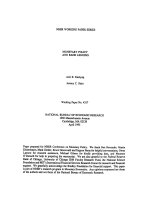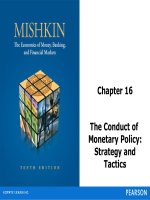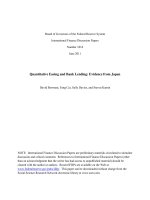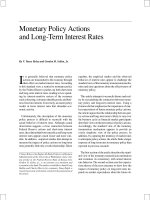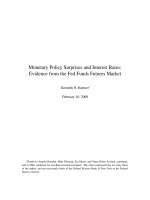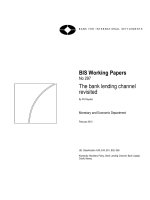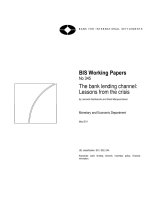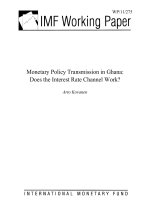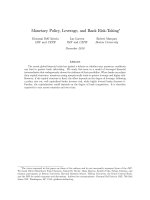Monetary policy transmission and bank lending channel in Vietnam
Bạn đang xem bản rút gọn của tài liệu. Xem và tải ngay bản đầy đủ của tài liệu tại đây (596.12 KB, 34 trang )
MINISTRY OF EDUCATION AND TRAINING
UNIVERSITY OF ECONOMICS HO CHI MINH CITY
*****
NGUYEN PHUC CANH
MONETARY POLICY TRANSMISSION AND
BANK LENDING CHANNEL IN VIETNAM
Major: Finance and Banking
Code: 62.34.02.01
SUMMARY OF PHD THESIS
ACADEMIC ADVISORS
1. Prof. Dr. SU DINH THANH
2. Assoc. Prof. Dr. VO XUAN VINH
HO CHI MINH CITY, 2016
LIST OF AUTHOR’S PUBLICATION
Articles
Võ Xuân Vinh, Nguyễn Phúc Cảnh (2015), “Các yếu tố ảnh hưởng đến kênh cho vay trong
truyền dẫn chính sách tiền tệ” (in English: The determinant of Bank lending channel in Monetary policy
transmission), Journal of Banking technologies 112, 7/2015, p.38-47, Ho Chi Minh City Banking
University, Vietnam.
Nguyễn Phúc Cảnh (2015), “Cơ chế truyền dẫn của Chính sách tiền tệ: Các nghiên cứu lý
thuyết và thực nghiệm trên thế giới” (in English: Monetary policy transmission: literature review),
Journal of banking science and training 154, 3/2015, p.29 – 41, Institution of Banking, Vietnam.
Võ Xuân Vinh & Nguyễn Phúc Cảnh (2014), “Monetary policy and bank credit risk in Vietnam
pre and post global financial crisis”, Contemporary Studies in Economic and Financial Analysis, Vol.
96; Risk Management Post Financial Crisis: A Period of Monetary Easing, Emerald Group Publishing
Limited, United Kingdom, p.277-290.
Nguyễn Phúc Cảnh, Trầm Thị Xuân Hương, Võ Xuân Vinh (2014), “Truyền dẫn của chính sách
tiền tệ: một số mô hình kiểm định phù hợp” (in English: Monetary policy transmission: some suitable
econometric testing models), Journal of Development and Integration 16 (26), P.41 - 46, 6/2014, UEF,
Vietnam.
Nguyễn Phúc Cảnh, Trầm Thị Xuân Hương, Võ Xuân Vinh (2014), “Nới lỏng định lượng và lạm
phát mục tiêu trên thế giới - bài học cho Việt Nam” (in English: Quantitative easing and inflation
targeting in the world and lessons for Vietnam), Journal of Banking technology 99, p.40 - 48, 6/2014,
Banking University Ho Chi Minh City, Vietnam.
Nguyễn Phúc Cảnh, Trầm Thị Xuân Hương, Võ Xuân Vinh (2014), “Truyền dẫn của chính sách
tiền tệ qua kênh lãi suất ngân hàng tại Việt Nam trước và sau khủng hoảng” (in English: Monetary
policy transmission through the interest rate channel in Vietnam before and after the crisis), Journal of
Economic Development 283, p.42 - 67, 5/2014, University of Economics Ho Chi Minh City, Vietnam.
Nguyễn Phúc Cảnh, Trầm Thị Xuân Hương, Võ Xuân Vinh (2014), “Truyền dẫn của chính sách
tiền tệ qua kênh tỷ giá tại Việt Nam – trước và sau khủng hoảng” (in English: Monetary policy
transmission through exchange rate channel in Vietnam - before and after the crisis), Journal of banking
science and training 143, p.27 - 35, 4/2014, Institution of Banking, Vietnam.
Nguyễn Phúc Cảnh (2014), “Truyền dẫn của chính sách tiền tệ qua kênh giá tài sản tài chính:
nghiên cứu thực nghiệm tại Việt Nam”, Journal of Integration and Development 19(29), 11-12/2014,
UEF.
Nguyễn Phúc Cảnh (2013), “Chính sách lạm phát mục tiêu- cơ chế giám sát độc lập và cơ hội
cho việt nam trong quá trình tái cấu trúc hệ thống ngân hàng thương mại” (in English: Inflation
targeting policy - independent monitoring mechanisms and opportunities for Vietnam in the restructuring
process of the commercial bank system), Journal of Integration and Development 13 (23), 11/2013, UEF,
Vietnam.
Nguyễn Phúc Cảnh, Nguyễn Quốc Anh, Nguyễn Hồng Quân (2013), “Đặc điểm ngân hàng tác
động đến sự truyền dẫn của chính sách tiền tệ qua kênh tín dụng ngân hàng tại Việt Nam” (In English:
Bank characteristics affecting the transmission of monetary policy through bank credit channel in Vietnam),
Journal of Economic Development 276, 10/2013, p.75 – 91, UEH, Vietnam.
Seminars
Võ Xuân Vinh, Nguyễn Phúc Cảnh (2014), “Monetary policy transmission in Vietnam: evidence
from a VAR approach”, the 27th Australasian Finance and Banking conference, 16 – 18 December 2014,
UNSW Business School, Sydney, Australia.
Trầm Thị Xuân Hương, Võ Xuân Vinh, Nguyễn Phúc Cảnh (2014), “Effect of monetary policy
to trade balance on open developing country: a case of Vietnam”, ICFE 2014 - The International
Conference on Finance and Economics Ton Duc Thang University, Ho Chi Minh City, Vietnam, June 2nd
- 4th, 2014.
Nguyễn Phúc Cảnh (2014), “Bank risk pre and post global financial crisis in Vietnam: a survey”,
ICFE 2014 - The International Conference on Finance and Economics Ton Duc Thang University, Ho Chi
Minh City, Vietnam, June 2nd - 4th, 2014.
Trầm Thị Xuân Hương, Võ Xuân Vinh, Nguyễn Phúc Cảnh (2014), “Hiệu quả công cụ lãi suất
trong điều hành chính sách tiền tệ Việt Nam” (in English: Effective tools in managing interest rate
monetary policy Vietnam), Workshop Summary some theoretical issues - over 30 years of practical
innovation, Economic University of Ho Chi Minh City, 01/21/2014.
Trầm Thị Xuân Hương, Nguyễn Phúc Cảnh (2013), “Truyền dẫn của Chính sách tiền tệ qua
kênh lãi suất ngân hàng thương mại ở Việt Nam” (in english: The transmission of monetary policy
through interest rate commercial banks in Vietnam), Risk Analysis Workshop in interest rates of
commercial banks operating in HCM City and precautions, Bank University, Vietnam.
Research projects
Nguyễn Phúc Cảnh, Võ Xuân Vinh (2015), “Vai trò của tỷ giá hối đoái trong điều hành chính
sách tiền tệ tại Việt Nam” (in English: the role of exchange rate in Vietnamese monetary policy
conducting), University of Economics Ho Chi Minh City, CS-2015-44.
Võ Xuân Vinh, Nguyễn Phúc Cảnh (2014), University research projects “Monetary policy and
bank credit risk in Vietnam pre and post global financial crisis”, University of Economics Ho Chi Minh
City, Vietnam (member).
Nguyễn Phúc Cảnh, Nguyễn Quốc Anh, Nguyễn Hồng Quân (2013), University research project:
“Đặc điểm ngân hàng tác động đến sự truyền dẫn của chính sách tiền tệ qua kênh tín dụng ngân
hàng tại Việt Nam” (in English: Bank characteristics affect to monetary policy transmission through
credit channel in Vietnam), University of Economics Ho Chi Minh City.
Book
Võ Xuân Vinh, Nguyễn Phúc Cảnh (2016), Referenced book: “Chính sách tiền tệ: nghiên cứu
ứng dụng các mô hình định lượng” (in English: Monetary policy: applied studies by econometric models),
UEH publishing house, University of Economics Ho Chi Minh City.
Abstract
This study tries to investigate the existing of interest rate channel, exchange rate channel, asset price
channel, and bank lending channel in Vietnam which are seen as the main channels in monetary policy
transmission. In addition, this study tries to investigate the determinants of bank lending channel and the
effects of the 2008 global financial crisis on bank lending channel in Vietnam. This study has found the
evidence of cost channel in Vietnam that reflects the ineffective of monetary policy in controlling inflation
thus it is a big challenge for Vietnamese policy makers in conducting monetary policy. But, this study did
not find statistical evidences of exchange rate channel and asset price channel which may be suggest that
they are weak or do not exist in Vietnam. This study found the evidences of bank lending channel in
Vietnam, it was also affected by the commercial bank characteristics such as bank capital, bank size. This
study also found that the 2008 global financial crisis had significant effects on bank lending channels which
is stronger in crisis.
First of all, this study has contribution to the empirical literature about the existence of cost channel in
a small open economy. Secondly, this study contributes empirical evidences of bank lending channel, the
determinants and the effects of the crisis on bank lending channel in an emerging market. Thirdly, this study
has major contributions to Vietnamese policy makers in conducting monetary policy and stabilizing the
banking system and financial markets, especially in the case of facing further external shocks in the future
such as the global crisis. With the academic contributions, this study defined that economists should test all
transmission channels in one model for better controlling the interactions between channels and better
measuring the effectiveness of each channel. With the empirical results, this study has significant practical
implications for Vietnamese policy makers in developing debt and equity markets, controlling the risky
activities of banking systems and applying unconventional monetary policies such as inflation targeting.
CHAPTER 1
INTRODUCTION
1.1.
The overview of Vietnamese economy and monetary policy
1.1.1.
The Vietnamese economy
The Vietnamese economy has gone through high growth periods from 1994 especially in period of 2000 to
2007. In which, it has had two slow periods due to the 1997 Asian economic crisis and the 2008 global
financial crisis.
1.1.2.
The State Bank of Vietnam
The operations of SBV were more apparent in the 2007 – 2012 period when the Vietnamese economy fell
into crisis. In 2010, the Vietnamese parliament approved the 2010 state bank act with changes in comparison
to the 2003 version, in which the most important change was the SBV’s function of monetary policy
conducting in article 2
1.1.3.
The Vietnamese monetary policy
SBV had expanded the monetary policy in the 2000 – 2007 period to cope with the 1997 Asian crisis and
to stimulate economic growth, then they expanded and tightened monetary policy on numerous occasions
in the 2008 – 2012 period.
1.1.4.
The Vietnamese monetary policy and macroeconomics factors
1.1.4.1.
Market interest rates
Market deposit rates and lending rates had changed in the same patterns with VNIBOR, they were stable at
a low level in the 2000 – 2007 period, but they fluctuated with the changes in monetary policy by increasing
in 2008, decreasing in 2009, increasing in 2010, 2011, and dropping in 2012.
1.1.4.2.
Inflation
The overheating economic growth, large and inefficient public investment, a sharp increase of aggregate
demand after joining WTO, long lasting budget deficit, high credit growth, and high money supply growth
in combination with the increase in the world commodity price, and other things had pushed Vietnamese
inflation to a high rate in 2008 – 2012 period.
1.1.4.3.
Exchange rate
The USD/VND rate increased from 10,966 in 1994 to 15,994 in 2006 and 20,293 in 2012, in which
USD/VND increased with a low stable step after 2000. But after 2007, the USD/VND continued a high rise
in 2008, 2009, 2010, and 2011, and stilled in 2012
1.1.4.4.
Credit
Credit was expanded quickly and broadly in 2000 – 2007 period from 50,000 billion VND in 1994 to over
700,000 billion VND in 2006 and over 3,200,000 billion VND in 2012.
1.1.4.5.
Stock markets
Vietnam developed stock markets in the early 21st century with Ho Chi Minh stock exchange in 2000 (HSX)
then Hanoi stock exchange in 2006 (HNX), but they are still small and lack of financial products for the
economy needs.
1.1.4.6.
Summary
Vietnamese economy grew rapidly in the 2000 – 2007 periods. The rapid economic growth was seemly
contributed from expansionary monetary policy, bank credit operations with low inflation and low interest
rates, and other elements. Monetary policy was expanded with low policy rates, high money supply growth
in the 2000 – 2007 period, but it reversed and change many times in the 2008 – 2012 period.
1.2.
Research objectives and questions
Firstly, this study attempts to test the existence of interest rate channel, exchange rate channel, and asset
price channel in Vietnam, these results are significant considerations for Vietnamese policy makers in
conducting the monetary policy. Furthermore, this study attempts to investigate the existence of bank
lending channels and then analyze the determinants of bank lending channel including the effects of the
2008 global financial crisis. In order to achieve these research objectives, this study goes to answer these
questions
1. Which do channels of interest rate channel, exchange rate channel and asset price channel exist in
Vietnam?
2. Does bank lending channel exist in Vietnam? And do bank size, bank capital, bank liquidity, bank
risk, and the 2008 global financial crisis effect on bank lending channels in Vietnam?
1.3.
The scope of this study
This study is going to examine the monetary policy transmission and bank lending channel in Vietnam in
period from 2003 to 2012.
1.4.
Research methodologies and data
1.4.1.
Methodologies
In the first main body, this study is going to use the VAR models to investigate the existence of interest rate
channel, exchange rate channel, and asset price channel in Vietnam through a monthly time series from
2003 to 2012 one by one. Then this study is going to use the SVAR model as the main model to check the
test the evidences of above channels. In the second main body, this study uses the system GMM model to
investigate bank lending channel in Vietnam, in which this study also measures the impacts of bank
characteristics and the 2008 global financial crisis on bank lending channel by yearly panel data in 2003 –
2012 period.
1.4.2.
Research data
This study will use two kinds of data: Vietnamese macroeconomic data and microeconomic data from
commercial banks in the 2003-2012 period.
1.5.
Some key concepts
Monetary policy, Central bank, Monetary policy targets, Monetary policy tools, Monetary policy
transmission, Bank lending channel
1.6.
The structure of study
Chapter 1: Introduction
Chapter 2: Theoretical framework and Literature review
Chapter 3: Methodologies
Chapter 4: Empirical evidences from Vietnam
Chapter 5: Conclusions and policy implications
CHAPTER 2
THEORETIAL FRAMEWORK AND LITERATURE REVIEW
2.1.
Monetary policy
2.1.1.
Introduction
Monetary policy is expressed in many aspects, it has seen as actions that are undertaken by central bank to
alter money supply or policy rates to aim at inflation stability, economic growth, fully employment, and
exchange rate stability (Araújo, 2015, Drakos and Kouretas, 2015, Sánchez, 2012).
2.1.2.
Central bank
Central bank is monopolized for printing and issuing money, it is also the government bank, the bank of
commercial banks, the lender of last resort, the manager of payment system, the agency for monetary policy
implementation, and the supervisor of the banking system (Blinder et al., 2008, Friedman, 1999).
2.1.3.
Monetary policy targets
Central bank conducts monetary policy to aim at economic stability, optimal unemployment, financial
system stabilizing, but price stability is always the most important target (Cecchetti and Krause, 2002,
Geraats, 2002, Issing, 2004, Spyromitros and Tuysuz, 2012, Van der Cruijsen and Demertzis, 2007, Jean
Louis and Balli, 2013).
2.1.4.
Monetary policy tools
Central bank uses different policy rates to conduct monetary policy such as rediscount rate, and interbank
offer rate. Central bank also buys or sells short-term securities on the open market to directly impact on
money supply and money demand thereby it has an effect on market interest rates and other economic
elements (Thành and Hằng, 2008). And they use mandatory reserve requirements to impact on money
supply since reserve requirements have a direct influence on the monetary creating multiplier that is created
by banking system.
2.1.5.
The ineffectiveness of monetary policy
Expansionary monetary policy sometimes can’t stimulate economic growth due to the liquidity trap (Dieppe
and McAdam, 2006). Deflation is also another problem in monetary policy conducting.
2.1.6.
Monetary policy and fiscal policy
The interactions between monetary policy and fiscal policy affect the effectiveness of overall
macroeconomic policies in many countries (Buti et al., 2001a, Buti et al., 2001b, Melitz, 2000, Leith et al.,
2015).
2.1.7.
Unconventional monetary policies
2.1.7.1.
Quantitative easing program
Quantitative easing program (QE) is an unconventional monetary policy to cope with the deflation and near
nil interest rate situation by the central banks in Japan, U.K., and U.S. The real effects of QE remain
controversial, yet it helped curb and prevent the crisis and promote economic growth in Japan (Girardin
and Moussa, 2011), but it couldn’t do the same in the case of the U.K. (Lyonnet and Werner, 2012).
2.1.7.2.
Inflation targeting policy
Inflation targeting policy originated in New Zealand in 1989, then many countries have applied this policy,
such as Chile, Canada, Israel, England, Sweden, Finland, Australia and Spain (Svensson, 2000). In inflation
targeting, central banks set an inflation target for monetary policy, and then will do anything to achieve this
target.
2.1.8.
Summary
Central banks conduct monetary policy to aim at price stability, economic growth, full employment, and
financial system stability. However, central banks can’t achieve all targets once, there are some tradeoffs
between targets such as inflation and unemployment. Central banks conduct monetary policy through policy
rates, open market operations, and reserve requirements to impact on aggregate demand and aggregate
supply through intermediate variables such as market interest rates, exchange rates, asset prices, and
expectations. Monetary policy may not take effect in the case of deflation, liquidity trap, or near nil interest
rates.
2.2.
Monetary policy transmission
2.2.1.
Conceptual framework
Monetary policy transmission is the process that transmits the changes in policy rates or money supply to
a series of other changes in economic variables such as market interest rates, asset prices, exchange rates,
cash flow, bank credit supply, private spending and consumption, etc. and ultimately aims at price, output
and unemployment (Mankiw and Taylor, 2011). The changes in money supply or policy rates of central
bank have an effect on other economic variables which are studied in the IS – LM model that is seen as the
basis of monetary policy transmission with forms many transmission channels.
2.2.2.
Monetary policy transmission channels
2.2.2.1. Interest rate channel
Central bank may change money supply and/or policy rates to alter real interest rates, investment, aggregate
demand, and output. The interest rate channel is confirmed by many studies as the main transmission
channel of monetary policy in many countries and areas (Friedman, 1956, Hannan and Liang, 1993, Taylor,
1995, Cecchetti, 1995).
2.2.2.2. Exchange rate channel
Besides IRC, ERC is also an important channel of monetary policy transmission (Golinelli and Rovelli,
2005, Demir, 2014), which transmits monetary policy through exchange rate to trade and investment
activities, and other international shocks, thus ERC will be almost ineffective in a closed economy.
Empirical studies confirm that ERC is an important transmission channel besides IRC in many countries.
However there are some cases such as Eritrea, Mengesha & Holmes (2013) didn’t find evidence of ERC,
but they found the existence of ERC in the illegal foreign exchange market.
2.2.2.3. Asset price channel
APC has two related mechanisms: Tobin's q theory and wealth effect, both mechanisms are related to the
relationship between the asset price with investment and consumption. APC exists in most developed
countries, yet it just exists in a few developing countries due to the lack of debt and equity security markets
(Mishra and Montiel, 2012).
2.2.2.4. Credit channel
Credit channel includes bank lending channels (BLC), balance sheet channels (BSC), cash flow channels
(CFC), unexpected price level channels (UPLC), and household effects liquidity (HLE). These subchannels are quite diversifiable from IRC, ERC, and APC because they mainly focus on the impact of
monetary policy on commercial bank credit and balance sheets of enterprises and households (Bernanke
and Gertler, 1995, Ramey, 1993, Iacoviello and Minetti, 2008, Kashyap and Stein, 1995, Ciccarelli et al.,
2014). Most studies about the credit channel have focused on large countries with comprehensive national
data such as the U.S. and European countries; they mainly focus on two main channels: the balance sheet
channel and the bank lending channel. Credit channel is found in U.S. (Bernanke and Blinder, 1992,
Kashyap and Stein, 2000, Kishan and Opiela, 2000, Liu and Minford, 2014, Orlowski, 2015), in European
(Altunbas et al., 2002, Mojon et al., 2002, Chrystal and Mizen, 2002, Altunbas et al., 2009), and many
countries.
2.2.2.5. Expectation channel
Expectation channel is hard to work separately because it helps exaggerate the effects of other channels.
Mukherjee and Bhattacharya (2011) and Dabla-Norris and Floerkemeier (2006) also mentioned about
expectation as a channel of monetary policy transmission.
2.2.3.
The lag and effectiveness of monetary policy transmission
2.2.3.1. The transmission lag of monetary policy
Price usually reacts slowly to monetary policy and it lags for about a year (Christiano et al., 1999, Mojon,
2001, Goodhart and Hofmann, 2001, Sander and Kleimeier, 2002, Hülsewig et al., 2009).
2.2.3.2. The effectiveness of monetary policy transmission
Monetary policy is not transmitted fully in the long term and in almost all countries due to transmission
barriers (de Bondt, 2002).
2.3. Bank lending channel
2.3.1.
Introduction
As one of the main transmission channels in the credit channel, bank lending channel supplements IRC to
strengthen the impact of monetary policy on economic variables through bank credit supply.
2.3.2.
Transmission mechanism
When central bank tightens monetary policy, funds of commercial banks are decreased, if they are difficulty
in issuing debt and equity instruments to offset the decrease in funds, they have to cut their credit supply
and vice versa (Bernanke and Blinder, 1988).
2.3.3.
Existing conditions
BLC will exist with some certain conditions in the economy, commercial banks and customer
characteristics: enterprises depend on funds from commercial banks (Bernanke and Blinder, 1988),
commercial banks can’t replace entire funds from deposits (Bernanke and Blinder, 1988), central bank can
impact on credit supply of commercial banks (Kashyap and Stein, 1995).
2.3.4.
Empirical evidences
The first study mentioned BLC as a channel of monetary policy transmission was Bernanke (1986) and
then other studies such as Bernanke et al. (1991), Bernanke and Blinder (1992), Kashyap et al. (1993), and
many studies have done with more details. BLC is found in Japan (Asako et al., 1989, Hoshi and Kashyap,
1990, Hayashi and Inoue, 1991, Ogawa and Suzuki, 1998), in South Korea (Ferri and Kang, 1999, Kim,
1999), in Germany (Barran et al., 1996, De Bondt, 2004, Ehrmann, 2004, Ehrmann and Worms, 2004,
Holtemöller, 2003, Hulsewig et al., 2001, Kakes and Sturm, 2002, Von Kalckreuth, 2001, Worms, 2001),
in European (Altunbas et al., 2002, Altunbas et al., 2009, Altunbas et al., 2010, Altunbas et al., 2012, Sander
and Kleimeier, 2004, Angeloni and Ehrmann, 2003, Bredin et al., 2001, Burgstaller, 2003, de Bondt, 2002,
De Bondt, 2004, Petturson, 2001, Kleimeier and Sander, 2000, Sander and Kleimeier, 2002, Toolsema et
al., 2001, Cantero-Saiz et al., 2014, Leroy, 2014, Apergis and Christou, 2015), and in many other countries
such as Indonesia, Canada, Thailand and in South Asia areas (Perera et al., 2014).
2.3.5.
Determinants of bank lending channel
2.3.5.1.
Macroeconomic conditions
BLC is different between countries because of differences in macroeconomic conditions, it will be stronger
in small economy with low-developed financial markets, but it is affected by locality characteristics. BLC
may be affected by the economic openness, crisis, economic structure, and also by level of public debt.
Especially, BLC will be stronger if central bank is more independence.
2.3.5.2.
The development of financial markets
BLC is weaker if financial markets are more development, it is also affected by financial market structure,
by financial transaction cost, and by innovations in financial markets.
2.3.5.3.
Regulations in banking sector
BLC is affected by the capital management and monitoring mechanisms of central bank, especially
regulations on interest rate and the transparency of macroeconomic policies.
2.3.5.4.
The competition in banking sector
BLC will be weaker if the banking sector is less competitive.
2.3.5.5.
Microeconomic determinants
The size of commercial bank. BLC is stronger in small commercial banks, in which small commercial
banks react to monetary policy shocks through credit supply, meanwhile large commercial banks react
through interest rate.
The capital of commercial bank. Commercial banks with capital barriers react stronger to contractionary
monetary policy, meanwhile they react weaker to expansionary monetary policy.
The liquidity of commercial bank. BLC is stronger at commercial banks with low liquidity, in which BLC
is weaker if the asset of commercial banks has better quality, and loan securitized activities may make BLC
weaker, but loan securitized activities sometimes may make BLC stronger.
The risk of commercial bank. Commercial banks always consider risk factor before responding to
monetary policy shocks thus BLC is affected by the risk of commercial banks.
The customer characteristics of commercial bank. Commercial banks with different customer segments
will react differently to monetary policy, in which BLC is stronger if customers of commercial bank are
small and medium enterprises, and if customers of commercial bank have more financial barriers, or the
industry of customers is more competitive. BLC is also affected by the behavior of enterprise managers,
and it is weaker if commercial banks have longer relationship with their customers.
The ownership of commercial bank. BLC is stronger at private commercial banks.
2.4. Studies of monetary policy transmission and bank lending channel in developing countries
Firstly, the proxy of monetary policy in developing countries. Beside the money supply the policy rate
especially short-term policy rates have been become the main proxy for monetary policy at developing
countries as in developed countries.
Secondly, the channels of monetary policy transmission. The monetary policy transmission in developing
countries such as Vietnam is difference country by country, but we are also noted by the evidences of many
empirical studies that the interest rate channel and the credit channel seemly are the main channels in
developing countries, meanwhile the exchange rate channel and the asset price channel may be weak due
to the characteristics of each country. In addition, the almost studies did not search or find the evidence of
expectation channel in developing countries due to the lack of data.
Thirdly, the bank lending channel. Bank lending channel may or may not exist that depend on the economic
conditions at each countries and it is strongly affected by the bank characteristics.
2.5. Studies of monetary policy transmission and bank lending channel in Vietnam
Using information from journals, electronic libraries, and doctoral thesis to search for studies of BLC in
Vietnams monetary policy transmission, I haven’t found any specific detailed study outside of Lân (2012),
but the study of Lân (2012) focused on the transmission channel and the role of the transmission channel
as well as the intensity of the BLC, he didn’t go into the details of characteristics and responses of
commercial banks in the BLC. A number of other studies relate to the relationship between the monetary
policy and commercial banks but they are not completely done and they are just the work of a master thesis
that has not been published, while they just take a short view on the monetary policy and commercial bank
operations and risk.
2.6.
Summary and research motivations
Studies of monetary policy have been done from the 1990s and thrived in the period after 2000 in Vietnam.
However, most of the studies have not applied the quantitative method due to the weakness of data statistics,
recent studies have used certain models but they were not abundant and they mainly focused on monetary
policy during and after the 2008 global financial crisis. There is almost no deep and careful study about
BLC in Vietnam, but related studies suggested evidence of the existing conditions for it. Besides that, most
studies do not have appropriate data with enough length of time and variables thus we need a research with
appropriate models and comprehensive data for Vietnam. There is clearly a research gap in monetary policy
transmission and monetary policy transmission via BLC in Vietnam.
CHAPTER 3
METHODOLOGY
3.1.
Monetary policy transmission testing models
3.1.1. The relationships between monetary policy, output and inflation
Monetary economists always try to explain the relationship between monetary policy, interest rate,
aggregate demand, output, and prices. Correlation between inflation and the growth rate of money supply
is almost 1, varying from 0.92 to 0.96, and it is dependent on the definition of money supply. This is
consistent with many previous studies such as Lucas (1980), Rolnick and Weber (1994). Thus when we
understand the relationships between them in both long-term and short-term, we can explain the
transmission of monetary policy in reality.
3.1.2. Estimating effects of monetary policy
Tools have been employed to estimate the impact of monetary policy evolved overtime because of timeseries econometrics development and changes in specific questions by theory. Tobin (1970) was the first
economist who formally modeled the idea that the positive correlation between money and output could
reflect the opposite view: the output might be caused by money. One of the first time-series econometric
studies tries to estimate effects of monetary policy is Friedman and Meiselman (1963). They try to test the
role of monetary policy in determining nominal income through equation:
𝑦"# = 𝑦" + 𝑝" = 𝑦(# +
*.( 𝑎* 𝐴",-
+
*.( 𝑏* 𝑚",-
+
*.( ℎ* 𝑧",-
+ 𝑢"
(3.1)
n
where: y denotes the log of nominal income, equals to the sum of logs of output and the price level, A is a
measure of autonomous expenditures, m is a monetary aggregate, and z is a vector of other variables relevant
for explaining nominal income fluctuations. Because effects of macroeconomic variables are usually
lagged, we suppose that estimated relationships between output and money are:
𝑦" = 𝑦( + 𝑎( 𝑚" + 𝑎- 𝑚",- + 𝑐- 𝑧" + 𝑐5 𝑧",- + 𝑢"
(3.3)
3.1.3. Database in study of monetary policy transmission
In studies of monetary policy transmission, data included macroeconomic elements such as policy rates,
money supply, reserve requirement, GDP, unemployment, industrial production, exchange rate, and
microeconomic elements that relate to specific transmission channels.
3.1.4. Proxy variables for monetary policy
3.1.4.1. Policy rates
According to the traditional economic theory, central banks change money supply to influence interest
rates rather than other economic variables. Nowadays, central bank mainly changes directly to policy
rates to conduct monetary policy thus policy rates are often used as a good proxy for monetary policy.
3.1.4.2. Money supply
Besides policy rates, money supply is one of the most important proxies of monetary policy. It is also the
intermediate target that central bank aims in monetary policy conducting.
3.1.5.
Variables of commercial bank characteristics in bank lending channel
Economists agree that commercial bank characteristics have impacted on monetary policy transmission via
BLC and they use three variables: scale, capital, and liquidity of banks (Kashyap and Stein, 2000). In which,
Bank scale is logarithm of total asset, Bank liquidity is ratio of liquidity assets to total assets, in which total
liquidity assets include total cash, deposits at central bank and other banks, investment securities, and short
– term securities), Bank capital is ratio of bank capital to total assets.
3.2.
Economic models for monetary policy transmission testing
3.2.1.
VAR and related models
3.2.1.1. VAR model
VAR was introduced by Sims (1972) and Sims (1980), it can be used by macro economists to quantify
responses of macro variables that do not require strong conditions to determine shocks. Then VAR
gradually becomes one of the most popular models used for time-series data over time.
3.2.1.2. SVAR model
Besides VAR, structural VAR model (SVAR) is also popularly used in the research of monetary policy
transmission in general and in particular with BLC. SVAR is widely used because SVAR helps clarify the
structural shocks and unstructured shocks which standard VAR models can’t clarify, meanwhile SVAR
also provides two tools to analyze monetary policy transmission: impulse response function and variance
decomposition.
3.2.2.
Cointegration models
3.2.2.1. ECM
ECM is a dynamic system with characteristics that the deviation of current state from its long-run
relationship will be fed into its short-run dynamics. ECM is a category of multiple time series models that
directly estimates the speed at which a dependent variable returns to long-term equilibrium after a change
in an independent variable (Engle and Granger, 1987).
3.2.2.2. VECM
VECM is an innovation of ECM that adds error correction features to a multi-factor model such as a
vector autoregression model.
3.2.2.3. ARDL
If two or more series have cointegration but they are not stationary at the same level, we have to use ARDL.
The ARDL of Pesaran and Shin (1998), Pesaran et al. (2001) has a number of features that many researchers
give it some advantages over conventional cointegration testing.
3.2.3.
DSGE model
Many researchers study monetary policy transmission
using VAR, but Dynamic stochastic general
equilibrium modeling (DSGE) is also used in the case we have all the utility functions of economic agents
such as households, firms, government, central bank (George et al., 2008, Cogley and Sargent, 2005).
3.2.4.
GMM model for panel data
GMM is often proposed to study monetary policy transmission through BLC in general and monetary policy
transmission through BLC in the case of caring effects of bank characteristics on BLC. GMM helps to solve
endogeneity and other problems in panel data (Arellano and Bond, 1991). In the GMM, widely alternatives
in within estimation are methods such as Arellano-Bond differences in Arellano & Bond (1991) and
Blundell-Bond system GMM (Blundell and Bond, 1998). GMM methods are considered superior to
alternatives in handling endogeneity, heteroskedasticity, serial correction and identification (Hall, 2003).
3.3.
Research methodologies for this study
3.3.1.
Research procedures and testing hypothesizes
This study goes into investigating the interest rate channel, asset price channel, exchange rate channel, and
bank lending channel in Vietnam by using three main models: VAR, SVAR, and GMM in 4 steps as
following:
Step 1 and 2. In order to answer the study’s question 1, this study uses the results from literature review in
chapter 2 to clarify the following testing hypothesizes: Hypothesis 1: the interest rate channel exists in
Vietnam, Hypothesis 2: the exchange rate channel may or may not exist in Vietnam, Hypothesis 3: the asset
price channel may or may not exist in Vietnam. In order to test these hypothesizes, this study builds VAR
and SVAR to test three main monetary policy transmission channels in Vietnam including the interest rate
channel, exchange rate channel, and asset price channel.
Step 3 and 4. This study goes to measure the existence and the impact of commercial bank characteristics
on bank lending channels by using the GMM model with the following hypothesizes: Hypothesis 4: the
bank lending channel is existed in Vietnam, Hypothesis 5: the bank lending channel is affected by bank
size, bank capital, bank liquidity and bank risk, Hypothesis 6: the BLC is affected by the 2008 global
financial crisis. In order to test these hypothesizes, this study recruits the GMM model which has been used
in many previous studies and is considered as an appropriate model for the bank lending channel with micro
data from commercial banks.
3.3.2.
Vietnam monetary policy transmission testing models
3.3.2.1. VAR model
This study uses VAR model which is used in study of Aleem (2010). VAR (p) is formed:
8
*.( 𝜑* 𝑌",*
= 𝜃𝑋" + 𝜀"
(3.18)
in which: Yt is endogenous vector of domestic variables, Xt is exogenous variables,𝜑, 𝜃 are coefficient
vector, ɛ: residual vector. Exogenous variables include world commodity index (Compiworld), U.S policy
rate (ius), and U.S. output (yus).
Xt = [Compiworld
ius
yus]
(3.19)
Meanwhile, the endogenous vector expresses Vietnam economic factors which include Vietnam industrial
production (IPVN) which presents for Vietnamese output, Vietnam price index (Prices), and Vietnam
monetary policy rate (i)
Yt = [IPVN
Prices
i]
(3.20)
In order to measure monetary policy transmission through the interest rate channel, exchange rate channel,
and asset price channel, this study also incorporates endogenous variables which represent each specific
channel including market interest rates, nominal effective exchange rate of USD/VND, and VNindex.
3.3.2.2. SVAR model
This study uses the SVAR model from study of Neri and d'Italia (2004) then adjust to the form as
Table 3.2. SVAR restriction matrix
ɛcp
1
0
0
0
0
0
0
0
ucp
ɛy
a21
1
0
0
0
0
0
0
uy
ɛms
0
a32
1
a34
a35
0
0
a38
ur
0
a42
a43
1
0
0
0
a48
um
ɛexc
a51
a52
a53
a54
1
0
0
0
uexc
ɛle
0
a62
a63
a64
0
1
0
0
ulr
ɛvni
a71
a72
a73
a74
a75
a76
1
0
uvni
ɛp
a81
a82
a83
a84
a85
a86
a87
1
up
ɛmd
=
Source: author’s building
In which: cp (world commodity price index), y (Vietnam industrial production), r (Vietnam policy rate), ms
(Vietnam money supply), md (Vietnam money demand), exc (Vietnam nominal exchange rate), le (Vietnam
lending rate), vni (Vietnam stock index), and p (Vietnam consumer price index). Structural shocks include:
ucp, uy, ur, um, uexc, ulr, uvni, and up are world price shock, domestic output shock, monetary policy shock,
money demand shock, international shock (exchange rate shock), lending interest rate shock, asset price
shock, and price shock respectively.
3.3.3.
Bank lending channel testing model
The model is used by Altunbas et al. (2010) has form:
H.( 𝛿H ∆ln(𝐺𝐷𝑃)L,",H + H.( 𝛽H ∆iO,",H +
H.( 𝜎H ∆iO,",H ∗ 𝑆𝐼𝑍𝐸*,",- + H.( 𝛾H ∆iO,",H ∗ 𝐿𝐼𝑄*,",- +
∆ln(𝐿𝑜𝑎𝑛𝑠)*," = 𝛼∆ln(𝐿𝑜𝑎𝑛𝑠)*,",- +
H.( ∅H ∆iO,",H ∗ 𝐸𝐷𝐹*,",- +
H.( 𝜋H ∆iO,",H ∗ 𝐶𝐴𝑃*,",- + 𝜏𝑆𝐼𝑍𝐸*,",- + 𝜗𝐿𝐼𝑄*,",- + 𝜖𝐶𝐴𝑃*,",-
+ 𝜑𝐿𝐿𝑃*,",- + 𝜔𝐸𝐷𝐹*,",- + 𝜀*,"
(3.33)
Source: Altunbas et al. (2010).
In which, Loan is outstanding loans of commercial banks, GDP is output, i is policy rate, EDF is expected
default frequency, SIZE is bank size, LIQ is bank liquidity, CAP is bank capital, LLP is bank loan loss
provision. The model equation has form:
Δln(loan)i,t = αln(loan)i,t-1 + σ2ln(GDP)t-1 + ϕ1Δit + ϕ2Δit-1 + φ1Δit*SIZEi,t-1 + τ1Δit*LIQi,t-1 + Ω1Δit*LLPi,t1+
¥1SIZEi,t-1 + ψ1Δit*CAPi,t-1 + ω1LIQi,t-1 + λ1CAPi,t-1 + µ1LLPi,t-1 + ɛi,t
(3.34)
Variables in this model are the same as Altunbas et al. (2010), loan growth is affected by monetary policy,
in particular through interest rate tool.
3.3.4.
Research data
Firstly, the monthly data from 2003 to 2012 which are used in VAR and SVAR models including world
commodity index (Compiworld), US policy rate (ius), and U.S. output (yus), Vietnam output (IPVN), Vietnam
price index (Prices), and Vietnam monetary policy rate (i), market interest rate (LER), the nominal exchange
rate of USD/VND (NEER), and VNindex (VNI) are compiled primarily from the International Monetary
Fund (IMF), General statistics office of Vietnam, and State bank of Vietnam. We also collect the SBV’s
rediscount rate (RDR), SBV’s refinance rate (RFR), and money supply (M2) in place of VNIBOR for
Vietnams monetary policy rate in order to test the consistence of VAR and SVAR models. Meanwhile, the
annual data which uses the GMM model are collected from financial reports of commercial banks in the
2003 – 2012 period, but some banks do not have full financial statements so unbalanced panel data is used,
while the GDP and Vietnam policy rates including VNIBOR, refinance rate and rediscount rate are
collected from ADB and SBV.
3.4.
Summary
This study uses VAR to test the existence of main transmission channels in Vietnam. Based on the results
of VAR, this study is going to use SVAR with short-term restrictions to test again Vietnam monetary policy
transmission through main channels in one system. Next, this study uses GMM with data from financial
reports of commercial banks to test the existence of a bank lending channel. These research methodologies
help us to ensure: the monetary policy transmission is tested by appropriate models and the estimation
problems are solved to avoid mistakes in the conclusions. With models and variables that are defined in
this section, the next chapter is going to use them for experimental studies.
CHAPTER 4
EMPIRICAL EVIDENCES FROM VIETNAM
4.1.
Monetary policy transmission
4.1.1.
Data
With macroeconomic data for VAR and SVAR models, this study collects and organizes a monthly time
series. Statistical descriptions are detailed in table 4.1.
Table 4.1. Data statistical description
OIL
LIBOR
IPUS
IPVN
CPI
VNIBOR
LER
NEER
VNI
Mean
69.71
2.16
103.81
52,001.
10.26
8.68
12.76
17,409.
Median
70.28
1.28
104.04
51,255.
8.41
7.51
11.18
Max
133.93
5.50
112.98
86,118.
28.36
17.57
Min
28.13
0.25
91.70
25,122.
2.05
Std.
24.81
1.90
4.80
16,939.
120
120
120
120
N
M2
RDR
RFR
443.09
1014930.
6.28
8.16
16,115.
421.90
816798.0
4.90
6.60
20.25
21,013.
1,137.
2590871.
13.00
15.00
5.22
9.30
15,417.
136.20
163090.
3.00
4.80
6.42
2.87
3.08
2,000.
233.89
726798.
3.23
3.15
120
120
120
120
120
120
120
120
Source: author’s calculation.
After stationary processing, short-term relationships between variables are tested through Granger causality
test (Granger, 1969, Granger, 1980).
Table 4.3. Granger causality test results
H01: VNIBOR no Granger cause to
H02: Variable no Granger cause to
variable
CPI
Variables
F-Statistic
p-value
F-Statistic
p-value
DLER
9.398
0.000
0.470
0.758
DLNEER
2.778
0.030
1.044
0.388
DLVNI
1.135
0.344
0.185
0.946
H03: VNIBOR no Granger cause to CPI
F-Statistic
p-value
2.210
0.073
Source: author’s calculation.
The Granger causality test is used for VNIBOR and CPI, and results show that VNIBOR has Granger
causality to CPI at 10% significance level (H03). This demonstrates that monetary policy has impacted on
price level but this impact can be transmitted through the interest rate channel (via DLER), exchange rate
channel (via DLNEER), but not asset price channel (via DLVNI).
4.1.2.
VAR model results
VAR model is used to test the existence of three channels: the interest rate channel, exchange rate channel,
and the asset price channel, one by one.
Interest rate channel
Figure 4.1. Impulse response function of CPI in IRC
Response to Cholesky One S.D. Innovations ± 2 S.E.
Res pons e of CPI to LIPVN
Res pons e of CPI to VNIBOR
3
3
2
2
1
1
0
0
-1
-1
-2
-2
1
2
3
4
5
6
7
8
9
10
11
12
1
2
3
4
Res pons e of CPI to DLER
5
6
7
8
9
10
11
12
10
11
12
Res pons e of CPI to CPI
3
3
2
2
1
1
0
0
-1
-1
-2
-2
1
2
3
4
5
6
7
8
9
10
11
12
1
2
3
4
5
6
7
8
9
Source: Author’s calculation.
Inflation reacts positively with Vietnams interbank offer rate and lending rates of commercial banks, which
defines the existence of a cost channel in Vietnam. This result confirms the existence of IRC in Vietnam
that also proves the hypothesis 1.
Exchange rate channel
Figure 4.2. Impulse response function for ERC
Response to Cholesky One S.D. Innovations ± 2 S.E.
Res pons e of CPI to LIPVN
Res pons e of CPI to VNIBOR
3
3
2
2
1
1
0
0
-1
-1
-2
-2
1
2
3
4
5
6
7
8
9
10
11
12
1
2
3
Res pons e of CPI to DLNEER
4
5
6
7
8
9
10
11
12
10
11
12
Res pons e of CPI to CPI
3
3
2
2
1
1
0
0
-1
-1
-2
-2
1
2
3
4
5
6
7
8
9
10
11
12
1
2
3
4
5
6
7
8
9
Source: author’s calculation.
Impulse response function results show no transmission of a monetary policy through the exchange rate
channel since inflation almost has no response to exchange rate shocks. This result confirms the hypothesis
2 that ERC may be weak or almost not exist in Vietnam.
Asset price channel
Figure 4.3. Impulse response function of VAR(5) for APC
Response to Cholesky One S.D. Innovations ± 2 S.E.
Res pons e of CPI to LIPVN
Res pons e of CPI to VNIBOR
3
3
2
2
1
1
0
0
-1
-1
-2
-2
1
2
3
4
5
6
7
8
9
10
11
12
1
2
3
Res pons e of CPI to DLVNI
4
5
6
7
8
9
10
11
12
10
11
12
Res pons e of CPI to CPI
3
3
2
2
1
1
0
0
-1
-1
-2
-2
1
2
3
4
5
6
7
8
9
10
11
12
1
2
3
4
5
6
7
8
9
Source: Author’s calculation.
APC via stock price may not exist in Vietnam due to a low-developed stock market, while other financial
intermediaries including commercial banks thrive and play an important role in capital markets. This result
confirms the hypothesis 3 that APC is weak or not exist in Vietnam.
4.1.3.
SVAR model results
Figure 4.4. Impulse response function of SVAR
Res pons e to Choles ky One S.D. Innovations ± 2 S.E.
Response of CPI to DLOIL
Response of CPI to LIPVN
Response of CPI to VNIBOR
3
3
3
2
2
2
1
1
1
0
0
0
-1
-1
-1
-2
-2
1
2
3
4
5
6
7
8
9
10
11
12
-2
1
2
Response of CPI to DLM2
3
4
5
6
7
8
9
10
11
12
1
3
3
2
2
2
1
1
1
0
0
0
-1
-1
-1
-2
-2
2
3
4
5
6
7
8
9
10
11
12
3
4
5
6
7
8
9
10
11
12
11
12
Response of CPI to DLER
3
1
2
Response of CPI to DLNEER
-2
1
2
3
Response of CPI to DLVNI
4
5
6
7
8
9
10
11
12
10
11
12
1
2
3
4
5
6
7
8
9
10
Response of CPI to CPI
3
3
2
2
1
1
0
0
-1
-1
-2
-2
1
2
3
4
5
6
7
8
9
10
11
12
1
2
3
4
5
6
7
8
9
Source: author’s calculation.
While responses of inflation to policy rate, money supply, and market interest rates reconfirm the existence
of a cost channel in Vietnam the same as the results from previous VAR models.
4.1.4.
Robustness check
In order to check the robustness of the models, M2 of Vietnam is collected to replace VNIBOR in proxy
for Vietnam’s monetary policy; IRC, ERC, and APC are tested by VAR model one by one.
Figure 4.5. Impulse response function of VAR for IRC with DLM2
Response to Cholesky One S.D. Innovations ± 2 S.E.
Res pons e of CPI to LIPVN
Res pons e of CPI to DLM2
3
3
2
2
1
1
0
0
-1
-1
1
2
3
4
5
6
7
8
9
10
11
12
1
2
3
Res pons e of CPI to DLER
4
5
6
7
8
9
10
11
12
10
11
12
Res pons e of CPI to CPI
3
3
2
2
1
1
0
0
-1
-1
1
2
3
4
5
6
7
8
9
10
11
12
1
2
3
4
5
6
7
8
9
Source: author’s calculation.
This result also confirms that policy rate is more effective in monetary policy conducting in comparing with
money supply of SBV because the money supply hasn’t affected the lending rates of commercial banks.
When we use RDR to replace for VNIBOR, Impulse response function shows that CPI has a strong positive
responses to DRDR, DLER so that IRC exists. The positive responses of CPI to policy rate and lending rate
indicate that a cost channel is exists as previous results in VAR and SVAR models. The robustness test is
continued with a new proxy for Vietnam monetary policy: refinance rate (RFR). Results show the same
idea with the rediscount rate because SBV has changed both RDR and RFR have the same pattern.
4.2.
Bank lending channel in Vietnam
4.2.1.
Data
We used a unique dataset of bank balance sheet items and macroeconomic variables for Vietnam over the
period from 2003 to 2012. Our data was collected from different sources, bank characteristics data are hand
collected from financial reports and annual reports, other data are from ADB and other sources.
Table 4.9. GMM data description
LnLOAN
SIZE
LIQ
CAP
LLP
Δi
LnGDP
ΔRFR
ΔRDR
Mean
16.320
17.260
0.381
0.130
1.180
0.188
14.271
0.663
0.631
Maximum
19.990
20.242
0.823
0.712
7.425
6.143
14.795
5.330
-4.430
Minimum
11.478
12.198
0.036
0.027
0.032
-5.339
13.481
-3.920
5.750
Std. Dev.
1.700
1.556
0.149
0.103
1.005
3.847
0.403
2.800
3.094
282
283
282
279
271
300
270
270
N (ind.)
282
Source: author’s calculation.
4.2.2.
GMM results and discussions
In order to examine the bank lending channel, we should put all determinants into one model which is
presented in table 4.11.
Table 4.11. Bank lending channel with whole effects of bank characteristics
Δln(loan)t
Whole effects without risk
Whole effects
Coeff.
P-Value
Coeff.
P-Value
ln(loan)t-1
-0.595***
0.000
-0.621***
0.000
Ln(GDP) t-1
0.417***
0.003
0.420***
0.003
Δi
-0.207***
0.009
-0.212**
0.029
Δit-1
-0.021***
0.002
-0.021***
0.002
Δi*sizet-1
0.010**
0.019
0.010*
0.080
Δi*capt-1
0.041
0.449
0.044
0.439
Δi*liqt-1
0.012
0.700
0.013
0.721
0.039
0.979
Δi*llpt-1
sizet-1
0.172
0.205
0.197
0.155
capt-1
-0.093
0.773
-0.007
0.984
liqt-1
0.174
0.542
0.144
0.620
llpt-1
2.439
0.552
2.926
0.503
AR(-2) test (p-value)
0.955
0.913
Sargan test (p-value)
N
0.128
182
0.125
182
*, **, *** indicate significance level of 10%, 5% and 1% respectively
Source: author’s calculation.
The results are consistent with all above findings with these results means that a bank lending channel exists
in Vietnam, and especially Vietnamese commercial banks have risk-taking action in responding with
monetary policy. But as the study of Nguyen and Boateng (2013), then Nguyen and Boateng (2015a) and
Nguyen and Boateng (2015b) suggest that when we use commercial bank characteristics to investigate the
bank lending channel we will face to problem of data normalization due to the heteroskedasticity between
commercial banks thus we should standardize commercial bank data to be more reliable measurement of
bank characteristics. Thus, this study standardizes the data of commercial bank characteristics by counting
the mean of each characteristics including bank size, bank capital, bank liquidity and bank loan loss
provision for each bank, then we minus the value of each characteristic for its mean one by one for each
bank. Table 4.13 presents estimation results when we put all variables into one model, these results are
interesting.
Table 4.13. Bank lending channel with whole effects by new measure of bank characteristics
Δln(loan)t
Whole effects without risk
Whole effects
Coeff.
P-Value
Coeff.
P-Value
ln(loan)t-1
-0.548***
0.000
-0.548***
0.000
Ln(GDP) t-1
0.323***
0.005
0.322***
0.005
Δi
-0.040***
0.000
-0.039***
0.000
Δit-1
-0.025***
0.000
-0.025***
0.000
Δi*sizet-1
0.043***
0.000
0.042***
0.000
Δi*capt-1
0.222***
0.001
0.217***
0.001
Δi*liqt-1
-0.006
0.901
0.001
0.979
0.773
0.593
Δi*llpt-1
sizet-1
0.188
0.101
0.189*
0.099
capt-1
0.470
0.111
0.478
0.105
liqt-1
0.323
0.186
0.324
0.185
llpt-1
1.960
0.575
1.474
0.683
AR(-2) test (p-value)
0.967
0.955
Sargan test (p-value)
0.305
0.275
N
182
182
*, **, *** indicate significance level of 10%, 5% and 1% respectively
Source: author’s calculation.
These results also confirm the consistent of our findings, this also indicates the significant effects of bank
capital on bank lending when Vietnamese commercial banks respond to monetary policy rate.
4.2.3.
Robustness test
Firstly, rediscount rate (RFR) and refinance rate (RDR) are used to replace for VNIBOR in proxy for
Vietnamese monetary policy, but all the bank characteristics are measured by standardized way as we
presented in previous section due to better results in GMM. Estimation results from GMM with RFR and
RDR indicate the same evidence as in GMM with VNIBOR in all aspects. Continue with the GMM model,
this study replaces VNIBOR by rediscount rate (RDR). Results show the same evidences as in the GMM
model with RFR and VNIBOR. So that, we can confirm the consistency of our findings in this section.
4.2.4.
The effects of the crisis on the bank lending channel in Vietnam
In order to investigate the effects of the 2008 global financial crisis on the bank lending channel in Vietnam,
we can divide the data into two sub-periods including pre-crisis and post-crisis periods, but due to the lack
of data this study does not use this method. Instead, we use the proxy for the 2008 global financial crisis,
this is VIX (the implied volatility of S&P 500 options contracts) that is suggested to be used to investigate
the impacts of the crisis (Druck et al., 2015). The results show the same evidence as previous estimations
in section 4.2.1 and 4.2.2 for the same variables. While the significant positive effects of VIX on bank
lending indicate that Vietnamese commercial banks expand their lending in crisis periods, that means the
bank lending channel is stronger in crisis periods. Meanwhile, the interaction terms between policy rate,
bank size, bank capital and VIX have significant positive effects on bank lending of the Vietnamese
commercial banks and indicate that the bank lending channel is stronger in larger banks and higher
capitalized bank in crisis. These results confirm the hypothesis 6.
Table 4.18. The impacts of the 2008 global financial crisis on bank lending channel in Vietnam
Bank lending channel
Bank lending channel
Bank lending channel
with VNIBOR
with RDR
with RFR
Δln(loan)t
Coeff.
P-Value
Coeff.
P-Value
Coeff.
P-Value
ln(loan)t-1
-0.536***
0.000
-0.671***
0.000
-0.672***
0.000
Ln(GDP) t-1
0.372***
0.003
0.474***
0.000
0.476***
0.000
Δi
-0.041***
0.000
-0.043***
0.000
-0.048***
0.000
Δit-1
-0.031***
0.000
-0.030***
0.000
-0.032***
0.000
Δi*sizet-1*vix
0.002***
0.000
0.001***
0.000
0.002***
0.000
Δi*capt-1*vix
0.006***
0.007
0.006**
0.031
0.006**
0.031
Δi*liqt-1*vix
0.000
0.917
-0.001
0.604
-0.001
0.603
Δi*llpt-1*vix
0.024
0.650
0.036
0.563
0.041
0.556
sizet-1
0.116
0.324
0.233**
0.046
0.230**
0.049
capt-1
0.060
0.843
0.540*
0.067
0.509*
0.084
liqt-1
0.354
0.152
0.364
0.153
0.363
0.154
llpt-1
2.634
0.467
2.493
0.495
2.418
0.507
Vix
0.010***
0.001
0.007***
0.011
0.007***
0.010
AR(-2) test (p-value)
0.983
0.804
0.791
